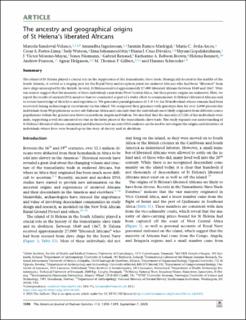| dc.contributor.author | Sandoval-Velasco, Marcela | |
| dc.contributor.author | Jagadeesan, Anuradha | |
| dc.contributor.author | Ramos-Madrigal, Jazmín | |
| dc.contributor.author | Ávila-Arcos, María C. | |
| dc.contributor.author | Fortes-Lima, Cesar A. | |
| dc.contributor.author | Watson, Judy | |
| dc.contributor.author | Johannesdóttir, Erna | |
| dc.contributor.author | Cruz-Dávalos, Diana I. | |
| dc.contributor.author | Gopalakrishnan, Shyam | |
| dc.contributor.author | Moreno-Mayar, J. Víctor | |
| dc.contributor.author | Niemann, Jonas | |
| dc.contributor.author | Renaud, Gabriel | |
| dc.contributor.author | Robson Brown, Katharine A. | |
| dc.contributor.author | Bennett, Helena | |
| dc.contributor.author | Pearson, Andrew | |
| dc.contributor.author | Helgason, Agnar | |
| dc.contributor.author | Gilbert, Marcus Thomas Pius | |
| dc.contributor.author | Schroeder, Hannes | |
| dc.date.accessioned | 2023-12-04T07:54:11Z | |
| dc.date.available | 2023-12-04T07:54:11Z | |
| dc.date.created | 2023-10-04T13:32:24Z | |
| dc.date.issued | 2023 | |
| dc.identifier.citation | American Journal of Human Genetics. 2023, 110 (9), 1590-1599. | en_US |
| dc.identifier.issn | 0002-9297 | |
| dc.identifier.uri | https://hdl.handle.net/11250/3105696 | |
| dc.description.abstract | The island of St Helena played a crucial role in the suppression of the transatlantic slave trade. Strategically located in the middle of the South Atlantic, it served as a staging post for the Royal Navy and reception point for enslaved Africans who had been “liberated” from slave ships intercepted by the British. In total, St Helena received approximately 27,000 liberated Africans between 1840 and 1867. Written sources suggest that the majority of these individuals came from West Central Africa, but their precise origins are unknown. Here, we report the results of ancient DNA analyses that we conducted as part of a wider effort to commemorate St Helena’s liberated Africans and to restore knowledge of their lives and experiences. We generated partial genomes (0.1–0.5×) for 20 individuals whose remains had been recovered during archaeological excavations on the island. We compared their genomes with genotype data for over 3,000 present-day individuals from 90 populations across sub-Saharan Africa and conclude that the individuals most likely originated from different source populations within the general area between northern Angola and Gabon. We also find that the majority (17/20) of the individuals were male, supporting a well-documented sex bias in the latter phase of the transatlantic slave trade. The study expands our understanding of St Helena’s liberated African community and illustrates how ancient DNA analyses can be used to investigate the origins and identities of individuals whose lives were bound up in the story of slavery and its abolition. | en_US |
| dc.language.iso | eng | en_US |
| dc.publisher | Elsevier B. V. | en_US |
| dc.rights | Attribution-NonCommercial-NoDerivatives 4.0 Internasjonal | * |
| dc.rights.uri | http://creativecommons.org/licenses/by-nc-nd/4.0/deed.no | * |
| dc.title | The ancestry and geographical origins of St Helena's liberated Africans | en_US |
| dc.title.alternative | The ancestry and geographical origins of St Helena's liberated Africans | en_US |
| dc.type | Peer reviewed | en_US |
| dc.type | Journal article | en_US |
| dc.description.version | publishedVersion | en_US |
| dc.source.pagenumber | 1590-1599 | en_US |
| dc.source.volume | 110 | en_US |
| dc.source.journal | American Journal of Human Genetics | en_US |
| dc.source.issue | 9 | en_US |
| dc.identifier.doi | 10.1016/j.ajhg.2023.08.001 | |
| dc.identifier.cristin | 2181657 | |
| cristin.ispublished | true | |
| cristin.fulltext | original | |
| cristin.qualitycode | 2 | |

